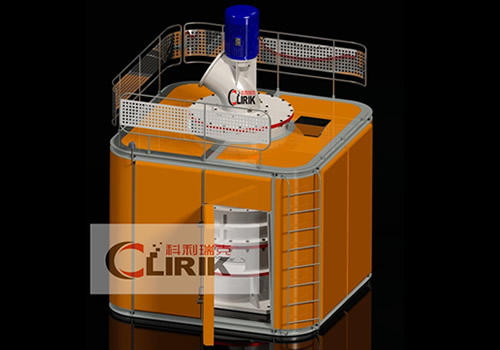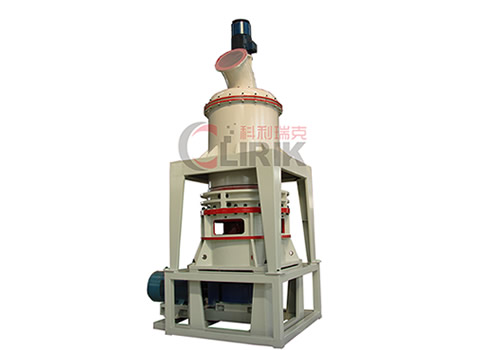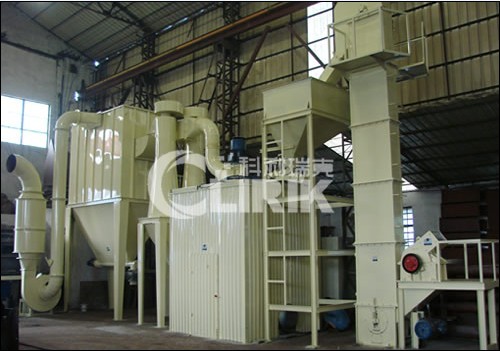The industrial use of barite powder:
Some 77% worldwide is used as a weighting agent for drilling fluids in oil and gas exploration to suppress high formation pressures and prevent blowouts. As a well is drilled, the bit passes through various formations, each with different characteristics. The deeper the hole, the more barite is needed as a percentage of the total mud mix. An additional benefit of barite is that it is non-magnetic and thus does not interfere with magnetic measurements taken in the borehole, either during logging-while-drilling or in separate drill hole logging. Barite used for drilling petroleum wells can be black, blue, brown or gray depending on the ore body. The barite is finely ground so that at least 97% of the material, by weight, can pass through a 200-mesh (75-μm) screen, and no more than 30%, by weight, can be less than 6 μm diameter.
To make barite into powder, there is
barite pulverizer machine, SHANGHAI CLIRIK barite pulverizer machine, the granularity (or final size) of the finished products can be freely adjusted between 325-3000meshes (0.045-0.0057mm), and the capacity (ton/hour) ranges from 0.4T/H to 12T/H.
Working principle of barite pulverizer machine:
HGM series
barite pulverizer machine mainly consist of main unit, classifier, powder collector, dust cleaner, blower, muffler, sound-proof room, crusher, bucket elevator, storage hopper, and vibrating feeder.
After crushed by hammer crusher, the large materials become small ones and are sent to storage hopper by elevator, and then evenly sent to the upper distribution plate of the turn plate by vibrating feeder and sloping feeding pipe.
When the
barite pulverizer machine is at work, all the grinding rollers are rolling in the ring, and the materials are driven to the edge of the turnplate by the centrifugal force and fall down into the grinding chambers where the materials are repeatedly pressed, crushed and grinded by the rollers.
The high-pressure air blower constantly inhales air within the
barite pulverizer machine and, in turn, the airflow with crushed materials are brought to the classifier whose high-speed impeller will screen the airflow: the unqualified particle size will fall and return to the mill for being reground while the qualified particle size mixed with air will go into the cyclone powder collector. Most of the qualified powders will fall and exit from the discharging valve at the bottom; a small proportion of the fine powders, with airflow, moves to the dust cleaner, and clings to the surface of the filter bags. At the same time, the fine powders clinging to the surface fall down by the sudden vibration of the filter bags, which is caused by the instantly ejected high-pressure gas controlled by the pulse valve. The materials from the above two lots are sent by the conveyor at the bottom to get finished powders packed. In addition, filtered clean air will be emitted from the air outlet of muffler in the end.
Technical data of barite pulverizer machine:
|
Model |
HGM80 |
HGM90 |
HGM100 |
HGM125 |
HGM168L |
|
Ring Diameter(mm) |
800 |
900 |
1000 |
1250 |
1680 |
|
Ring Number (PCS) |
3 |
3-4 |
4 |
4 |
4 |
|
Roller Number(PCS) |
18-21 |
24-29 |
28-36 |
30-44 |
30-40 |
|
Main Shaft Speed (r. p. min) |
230-240 |
200-220 |
180-200 |
135-155 |
120-130 |
|
Input Size (mm) |
≤10 |
≤10 |
≤15 |
≤15 |
≤20 |
|
Finished Size (um/mesh) |
74-5
(200-2500) |
74-5
(200-2500) |
74-5
(200-2500) |
100-6
(150-2000) |
100-9
(150-1500) |
|
Capacity (t/h) |
0.4-4.5 |
0.6-6.5 |
1-9 |
2-16 |
3.8-30 |
|
Outlet Size L*W*H (m) |
13.9*4*6.2 |
14.7*4.8*7.2 |
18*4.6*8.6 |
14*9*10.25 |
26.3*7.5*11.9 |
Note: This specification is just referencing, any changes are subject to the products.



